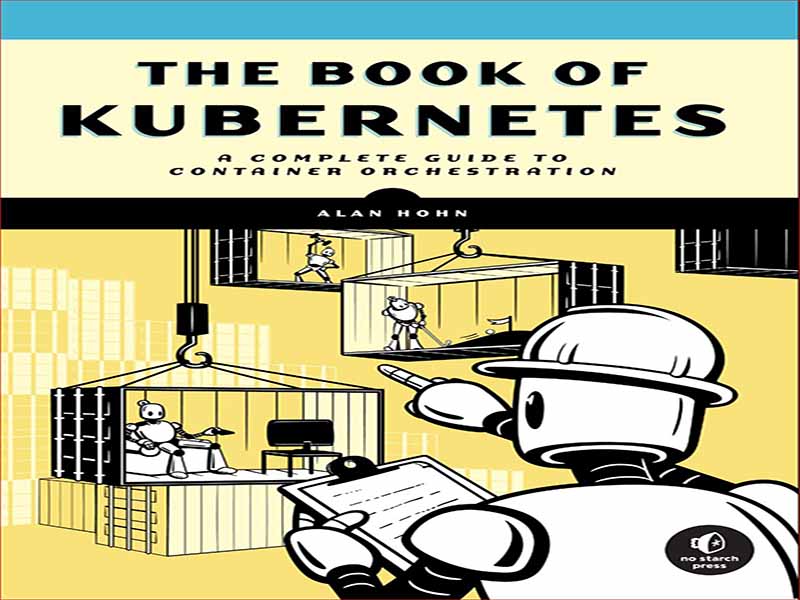- عنوان کتاب: THE BOOK OF KUBERNETES – A Complete Guide to Container Orchestration
- نویسنده: Alan Hohn
- حوزه: کوبرنتیز
- سال انتشار: 2022
- تعداد صفحه: 430
- زبان اصلی: انگلیسی
- نوع فایل: pdf
- حجم فایل: 2.43 مگابایت
Containerها و Kubernetes با هم در حال تغییر نحوه معماری، توسعه و استقرار برنامهها هستند. کانتینرها تضمین میکنند که نرمافزار بدون توجه به جایی که مستقر شده است، قابل اطمینان اجرا میشود، و Kubernetes به شما امکان میدهد همه کانتینرهای خود را از یک صفحه کنترل واحد مدیریت کنید. این کتاب برای کمک به شما در استفاده کامل از این فناوریهای جدید ضروری طراحی شده است، با استفاده از مثالهای عملی نه تنها برای آزمایش ویژگیهای اصلی، بلکه همچنین برای کشف نحوه عملکرد هر ویژگی. به این ترتیب، فراتر از آمادهسازی ساده برای استقرار یک برنامه کاربردی در Kubernetes، مهارتهای معماری برنامهها را به دست خواهید آورد تا در یک خوشه Kubernetes عملکردی و قابل اعتماد باشند و بهسرعت مشکلات را در صورت بروز آنها تشخیص دهید. بزرگترین مزیت خوشه Kubernetes این است که کار اجرای کانتینرها را در چندین میزبان در پشت یک لایه انتزاعی پنهان می کند. خوشه Kubernetes یک “جعبه سیاه” است که آنچه را که ما به آن میگوییم اجرا میکند، با مقیاسبندی خودکار، failover و ارتقا به نسخههای جدید برنامه ما اجرا میکند. حتی اگر این انتزاع استقرار و مدیریت برنامهها را آسانتر میکند، درک اینکه یک خوشه چه کاری انجام میدهد را نیز دشوار میکند. به همین دلیل، این کتاب هر یک از ویژگیهای زمان اجرا کانتینر و خوشههای Kubernetes را از منظر «اشکالزدایی» ارائه میکند. هر جلسه اشکال زدایی خوب با در نظر گرفتن برنامه به عنوان یک جعبه سیاه و مشاهده رفتار آن شروع می شود، اما به اینجا ختم نمی شود. حلکنندههای ماهر میدانند که چگونه جعبه سیاه را باز کنند، در زیر لایه انتزاعی فعلی غواصی کنند تا ببینند برنامه چگونه اجرا میشود، چگونه دادهها ذخیره میشوند و چگونه ترافیک در سراسر شبکه جریان دارد. معماران ماهر از این دانش عمیق یک سیستم برای جلوگیری از مشکلات عملکرد و قابلیت اطمینان استفاده می کنند. این کتاب درک دقیقی از کانتینرها و Kubernetes را ارائه می دهد که تنها از کاوش نه تنها این فناوری ها بلکه نحوه عملکرد آنها نیز حاصل می شود. در قسمت اول، ما با اجرای یک کانتینر شروع میکنیم، اما سپس به زمان اجرای کانتینر میپردازیم تا بفهمیم یک کانتینر چیست و چگونه میتوانیم یک کانتینر را با استفاده از دستورات عادی سیستم عامل شبیهسازی کنیم. در قسمت دوم، ما یک خوشه Kubernetes را نصب کرده و کانتینرها را در آن مستقر خواهیم کرد. همچنین خواهیم دید که خوشه چگونه کار می کند، از جمله اینکه چگونه با زمان اجرا کانتینر تعامل می کند و چگونه بسته ها از ظرفی به کانتینری در سراسر شبکه میزبان جریان می یابند. هدف این نیست که مستندات مرجع را کپی کنیم تا همه گزینههای ارائه شده توسط هر ویژگی را نشان دهیم، بلکه نشان دهیم که هر ویژگی چگونه پیادهسازی میشود تا همه آن مستندات منطقی و مفید باشند. یک خوشه Kubernetes پیچیده است، بنابراین این کتاب شامل نمونههای عملی گسترده است، با اتوماسیون کافی که به شما امکان میدهد هر فصل را به طور مستقل کاوش کنید. این اتوماسیون، که در https://github.com/book-of-kubernetes/examples موجود است، تحت یک مجوز منبع باز مجاز منتشر شده است، بنابراین شما می توانید آن را کاوش، آزمایش و در پروژه های خود استفاده کنید.
Containers and Kubernetes together are changing the way that applications are architected, developed, and deployed. Containers ensure that software runs reliably no matter where it’s deployed, and Kubernetes lets you manage all of your containers from a single control plane. This book is designed to help you take full advantage of these essential new technologies, using hands-on examples not only to try out the major features but also to explore how each feature works. In this way, beyond simply being ready to deploy an application to Kubernetes, you’ll gain the skills to architect applications to be performant and reliable in a Kubernetes cluster, and to quickly diagnose problems when they arise. The biggest advantage of a Kubernetes cluster is that it hides the work of running containers across multiple hosts behind an abstraction layer. A Kubernetes cluster is a “black box” that runs what we tell it to run, with automatic scaling, failover, and upgrades to new versions of our application. Even though this abstraction makes it easier to deploy and manage applications, it also makes it difficult to understand what a cluster is doing. For this reason, this book presents each feature of container runtimes and Kubernetes clusters from a “debugging” perspective. Every good debugging session starts by treating the application as a black box and observing its behavior, but it doesn’t end there. Skilled problem solvers know how to open the black box, diving below the current abstraction layer to see how the program runs, how data is stored, and how traffic flows across the network. Skilled architects use this deep knowledge of a system to avoid performance and reliability issues. This book provides the detailed understanding of containers and Kubernetes that only comes from exploring not only what these technologies do but also how they work. In Part I, we’ll begin by running a container, but then we’ll dive into the container runtime to understand what a container is and how we can simulate a container using normal operating system commands. In Part II, we’ll install a Kubernetes cluster and deploy containers to it. We’ll also see how the cluster works, including how it interacts with the container runtime and how packets flow from container to container across the host network. The purpose is not to duplicate the reference documentation to show every option offered by every feature but to demonstrate how each feature is implemented so that all that documentation will make sense and be useful. A Kubernetes cluster is complicated, so this book includes extensive hands-on examples, with enough automation to allow you to explore each chapter independently. This automation, which is available at https://github.com/book-of-kubernetes/examples, is published under a permissive open source license, so you can explore, experiment, and use it in your own projects.
این کتاب را میتوانید از لینک زیر بصورت رایگان دانلود کنید:
Download: THE BOOK OF KUBERNETES – A Complete Guide to Container Orchestration




































نظرات کاربران